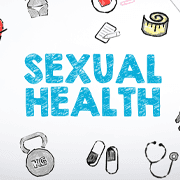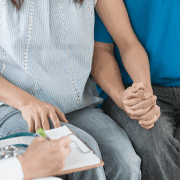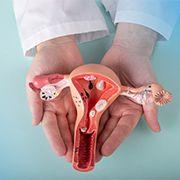Recognising STD symptoms: A Comprehensive Guide
In This Article
Recognising STD symptoms: A Comprehensive Guide
Dr. Sanjana
Updated on February 18, 2025
Medically verified by Dr. Arya
Fact checked by Dr. Pournami

Wellness
9 min
In case you aren’t aware, sexually transmitted diseases or STDs are infections that spread through sexual contact.
And STDs can affect a person’s physical as well as overall health.
Preventing and treating STDs are important. For that, it is crucial to know the symptoms.
Karepedia is here with a guide to help you recognise the common symptoms of STDs.
Also, we will help you understand the risks related to STDs through this blog. Let’s dive in.
STDs And Types
What is an STD? Or an STI? It stands for sexually transmitted diseases or infections and you guessed right, it is transmitted via sex.
Yes, STDs affect both men and women. And yes, most of them are treatable.
Let's delve into the different types of STDs present in men and women.
STDs are caused by bacterias, viruses and even parasites.
Here’s an non exhaustive list of most common STDs seen in India :
Bacterial - Gonorrhoea, Chlamydia, LGV - Lymphogranuloma venereum, Syphilis, Chancroid
Viral - HIV - Human Immunodeficiency Virus, HPV - Human Papillomavirus, Herpes, Hepatitis B, Hepatitis C
Parasitic- Trichomonas, Pubic lice
The main problem with STDs is that most of these diseases either have long incubation periods, or may be present in the mildest form. Most people overlook these mild symptoms and do not seek help.
Because of this latency and due to symptomless periods, most infections go undiagnosed. The problem arises here.
This leads to spread of the infection from one person to another. Hence it is vital to check for STDs in every sexually active individual routinely.
Experts advise annual check-ups.
Signs and Symptoms
STIs most commonly do not cause any symptoms. But when they do, they are as follows :
- Discharge from vagina or penis
- Ulcer
- Painful or burning micturition
- Pain during sex
- Pain abdomen
- Abnormal menstrual cycles
- Swollen lymph nodes
- Lower abdominal pain
- Fever
How Long Before Common STD Symptoms Appear?
| STD | Appearance of Symptoms |
| ---- | ----- |
| Chancroid | 1-4 days | = row 1
| Gonorrhea | 2-30 days | = row 2
| Trichomoniasia | 5-28 days(Women only) |
| Syphilis | 10-90 days |
| Chlamydia | 14-21 days |
| HIV | 14 days for some(Most are asymptomatic for years) |
| Genital Herpes | 2-14 days |
| Hepatitis B | 28-42 days |
| Scabies | 30-60 days(First time occurrence) |
| Genital Warts | 90 days |
Let’s take a look at each of these diseases individually.
Gonorrhoea
Gonorrhoea is the most common STD worldwide. It is a bacterial infection that affects your genital tract. It can also affect your eyes, mouth, throat and anus.
What’s tricky about this infection is it does not present with any symptoms for a long time. But when they do appear, you may experience:
- Pain during urination
- Abdominal pain
- Thick discharge through vagina or penis
- In women, heavy and irregular bleeding may also occur
- In men, testicles may be swollen
- If anus is involved, itching and pain during defecation is common
As you know, gonococcal infections take time to show up. How long does it take? Anywhere between 1-2 weeks. Most of you may not experience any symptoms.
Even though you have no symptoms, you can still transmit this infection to your partner. Annual screening is important for early detection and prompt treatment. Both you and your partner must be treated to prevent further spread.
Common complications of gonorrhoea are:
- Arthritis
- Infertility
- Pelvic inflammatory disease
- Ectopic pregnancy, premature birth
- Conjunctivitis
- Sepsis.
Chlamydia
This is also a bacterial infection. It also has the same clinical picture as Gonorrhoea.
Similar to gonorrhoea, at first, there might be no symptoms at all. In 2-3 weeks, symptoms begin to appear. This includes:
- Pain during urination
- Abdominal pain
- Pain during sex
- Thick discharge through vagina or penis
- In women, heavy cycles
Both, chlamydia and gonorrhoea, being bacterial infections can affect the genital tract. It also spreads upwards into the uterus and the uterine tubes.
This, in the long term and untreated, can cause infertility. Ultimately this will need surgery to control the infection.
LGV - Lymphogranuloma venereum
This is also caused by Chlamydia. Different strains of Chlamydia cause different types of diseases. This is rare in India.
You may have it if you have:
- An ulcer in the genital area which heals completely without any pain.
- In the next 2-6 weeks, painful and swollen glands in the groin may be expected.
Syphilis
This is another bacterial infection, transmitted through oral and vaginal sex. It also passes through the placenta. This means it can be transferred from mother to baby.
You may have this infection if you have a painless sore on your genital area. It can also present with:
- Rashes on other parts of your body including palms and sores
- Fever
- Swollen glands
- Body pain and tiredness
- In chronic and untreated conditions it also has a tendency to affect your eyes, nerves and heart - severe headache, numbness, paralysis, blindness, dementia, hearing difficulties, heart conduction abnormalities
- It also increases the risk of acquiring HIV by 2-fold
- In pregnancy it can cause deadly complications such as stillbirth, premature birth, and other long term sequelae as mentioned above.
 10mint
10mintSexual Health Matters: How To Maintain Your Sexual Health ?
 10mint
10mintYour Guide to Sexual Health Screening and Preventive Measures
 10 mints
10 mintsSTDs in Women: Comprehensive Guide on Symptoms and Treatments
Get a Callback Now
Chancroid
A bacterial infection, caused by Haemophilus ducreyi. It is quite rare to find this disease in India. Time taken to develop symptoms after infection is less than a week.
- It causes multiple, painful sores in the genital area with painful and swollen glands in the groin.
- Redness, shiny skin is also noted around the ulcer.
- Associated yellow-grey discharge is also noted.
HIV (Human Immunodeficiency Virus)
HIV is a common STD found worldwide. It spreads through sexual contact and through contact with contaminated blood.
It is also transmitted in pregnancy from mother to child. It does not spread through air, water, pets, insects, sharing food and drinks, sweat, saliva or tears from an infected person. It comes in different stages:
- STAGE 1 : Initial stage of infection with high viral copies. Many experience flu-like illness with fever, cold, fatigue, headache, sore throat and body pain.
- STAGE 2 : This is the latent phase. The virus continues to multiply but physically has no symptoms.
This stage can last as long as a couple of decades. If you receive timely management, the disease does not progress to stage 3.
- STAGE 3 : This is full blown HIV known as AIDS - acquired immunodeficiency syndrome.
In this stage, the immune system is roasted. It paves way for other infections because of the fallen immune system.
Virus can be transmitted in all 3 stages of the infection.
HIV is not curable. It is, however, treated to control the infection and prevent its complications.
The treatment reduces the viral load. If you are adherent to the treatment, the viral load reduces to undetectable levels. At this stage,you can lead a normal healthy life without transmitting HIV to your HIV- negative partner.
HPV (Human Papillomavirus)
A very common virus found in most sexually active individuals. HPV, like others, has over 200 different strains.
1. High risk HPV : Among these, 2 strains namely HPV 16 and 18 are known to cause cancer. They can cause cervical cancer, penile cancer, anal cancer, oral cancer, vaginal and vulvar cancer.
2. Low risk HPV : These strains cause an STD known as warts around the genitals, mouth and anus. It can also affect the throat and vocal cords.
Warts are small, uneven skin growth on genital areas and other parts of the body as well. Picking the warts will spread the virus and should be avoided. Use separate razors, nail clippers and brushes.
Herpes
Herpes is a very common viral infection. It is of 2 types.
HSV - 1 : Herpes simplex 1, causes oral herpes affecting everything around the mouth. This includes lips, tongue, and oral lining. It presents as painful blisters, which later bursts open to form open sores.
They then crust and heal completely. Fever, swollen glands, headache and other flu- like symptoms are also common.
HSV - 2 : Herpes simplex 2 causes genital herpes. It presents the same way as oral herpes. You have this if you have swollen glands, fever and tingling sensation around the sores.
Burning sensation while urinating with or without leg pain is also seen.
You may also experience both oral and genital lesions at the same time. Herpes also increases the risk of contracting other STDs such as HIV.
Hepatitis B and Hepatitis C
Both forms of Hepatitis are transmitted sexually and also via blood. It is also transmitted via shared needles and transplacentally from mother to child.
Both affect the liver. They may remain silent like other STDs. but, at times present as an acute condition.
Symptoms include:
- Fever
- Right upper abdominal pain
- Fatigue
- Vomiting and nausea
- Jaundice, dark coloured urine
- Itching
- Joint pain
Apart from the acute condition of hepatitis, hepatitis B and C can lead to long-term carrier states. During this phase, the virus can spread from person to person.
Hepatitis B and C are chronic illnesses treated only to limit the virus. It cannot be cured. But if left untreated it can cause cirrhosis (a chronic inflammatory liver disease), liver cancer and end stage liver disease.
Trichomonas
A protozoan STD. Like other STDs, it can affect both men and women. It mainly infects the lower genital tract - cervix, vagina and vulva in women, urethra in men and women.
Symptoms develop in 1-4 weeks and they include:
- Thin, foul smelling, grey - green discharge from vagina or penis
- Genital redness and itching is common
- Pain during sex
- Burning sensation while urinating and ejaculation in men
- In pregnancy, trichomonas infection can cause prematurity.
Trichomonas also increases the risk of contracting other STIs. It also increases the risk of cervical and prostate cancer.
Additional Prevention Strategies
- Get Vaccinated. Many vaccines are available in the market for STDs such as HPV (Gardasil 9), Hepatitis B and more.
- Annual testing for STDs is useful for early detection and prompt treatment.
- Avoid multiple sexual partners.
- Use barrier methods of contraceptives such as condoms and dental dams.
- Avoid excessive alcohol intake and use of illegal drugs.
- Male circumcision reduces the risk of HIV by 60%. It also prevents penile cancer and warts from HPV.
STDs often have mild or asymptomatic presentations, leading to undiagnosed cases. Regular, annual testing for sexually active individuals is crucial for early detection and treatment.
Familiarise yourself with common symptoms of STDs, which include discharge from the genitals, ulcers, painful urination, abdominal pain, and swollen lymph nodes, among others.
Understand the modes of transmission for various STDs, which can include sexual contact, contaminated blood, and mother-to-child transmission during pregnancy or childbirth.
Untreated STDs can lead to serious complications such as infertility, pelvic inflammatory disease, arthritis, liver disease, and increased susceptibility to other infections, including HIV.
Practise preventive strategies such as vaccination (e.g., HPV, Hepatitis B), consistent condom use, limiting sexual partners, avoiding sharing needles, and maintaining overall sexual health through regular check-ups and healthy lifestyle choices.
Source Links
PubMed Central

